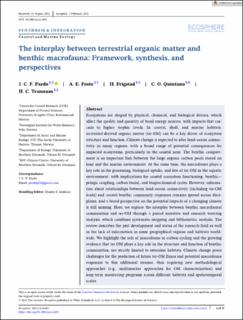| dc.description.abstract | Ecosystems are shaped by physical, chemical, and biological drivers, which affect the quality and quantity of basal energy sources, with impacts that cascade to higher trophic levels. In coastal, shelf, and marine habitats, terrestrial-derived organic matter (ter-OM) can be a key driver of ecosystem structure and function. Climate change is expected to alter land–ocean connectivity in many regions, with a broad range of potential consequences for impacted ecosystems, particularly in the coastal zone. The benthic compartment is an important link between the large organic carbon pools stored on land and the marine environment. At the same time, the macrofauna plays a key role in the processing, biological uptake, and fate of ter-OM in the aquatic environment, with implications for coastal ecosystem functioning, benthic–pelagic coupling, carbon burial, and biogeochemical cycles. However, information about relationships between land–ocean connectivity (including ter-OM loads) and coastal benthic community responses remains spread across disciplines, and a broad perspective on the potential impacts of a changing climate is still missing. Here, we explore the interplay between benthic macrofaunal communities and ter-OM through a paired narrative and research weaving analysis, which combines systematic mapping and bibliometric analysis. The review describes the past development and status of the research field as well as the lack of information in some geographical regions and habitats worldwide. We highlight the role of macrofauna in carbon cycling and the growing evidence that ter-OM plays a key role in the structure and function of benthic communities, not strictly limited to estuarine habitats. Climate change poses challenges for the prediction of future ter-OM fluxes and potential macrofauna responses to this additional stressor, thus requiring new methodological approaches (e.g., multimarker approaches for OM characterization) and long-term monitoring programs across different habitats and spatiotemporal scales. | en_US |

